Updated: 4/1/2024 | Best Korean Dishes to Try
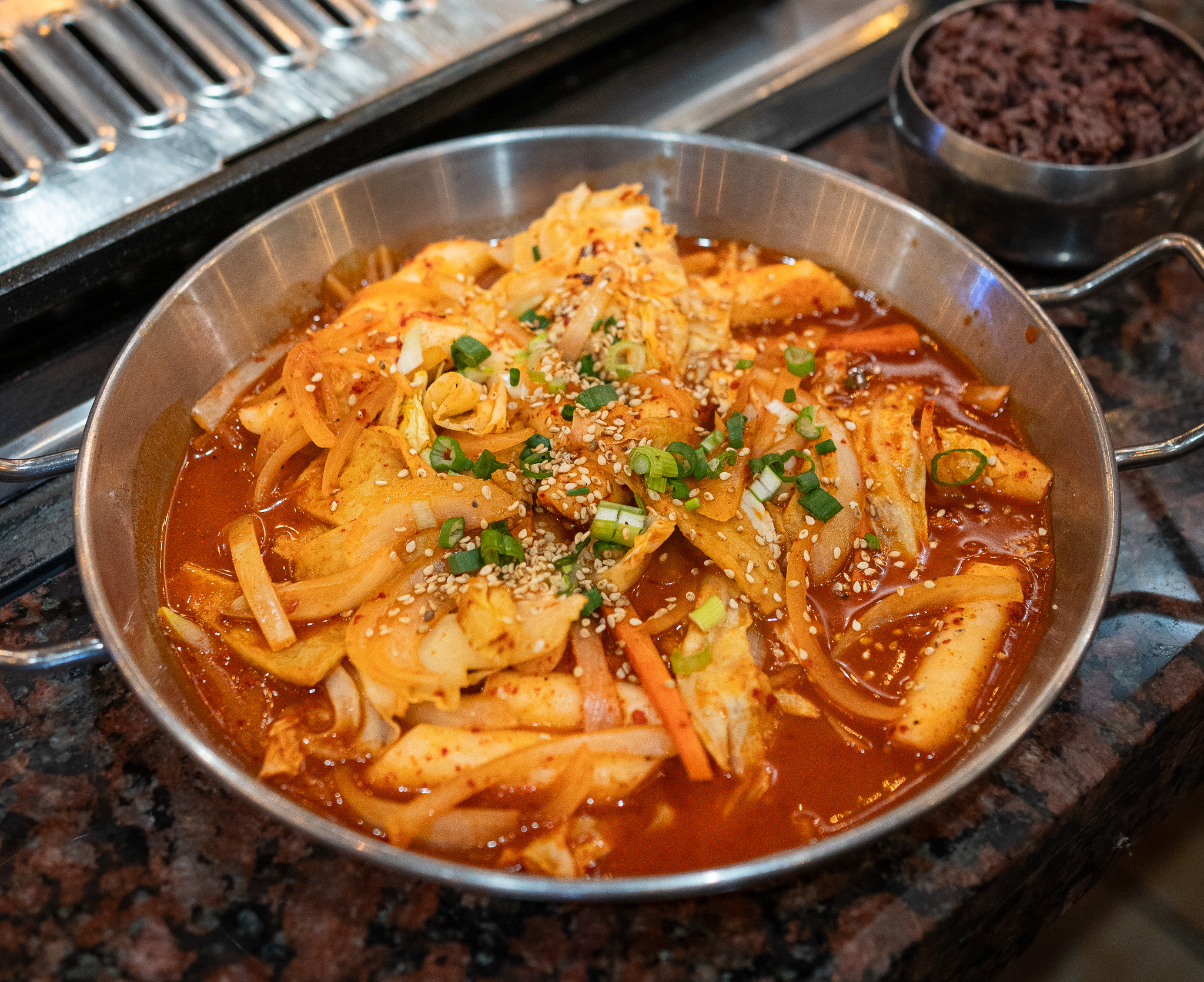
Tteokbokki from New Gangnam KBBQ in Lynnwood, WA
My next favorite food, aside from Vietnamese food, is Korean food!
Korean foods are packed with fermented and fishy goodness. Many of their dishes may look violently red, but rest assured many of their dishes are more flavor-packed than unbearably spicy.
We also admire how enthusiastically Koreans embrace cuts of meat on a hot grill. Korean BBQ is an institution that brings just about everyone together at the dinner table.
Below we’ll go over the best Korean dishes you should try the next time you head to a Korean restaurant.
Best Korean Dishes to Try
Appetizers
#1 Korean Fried Chicken (KFC)
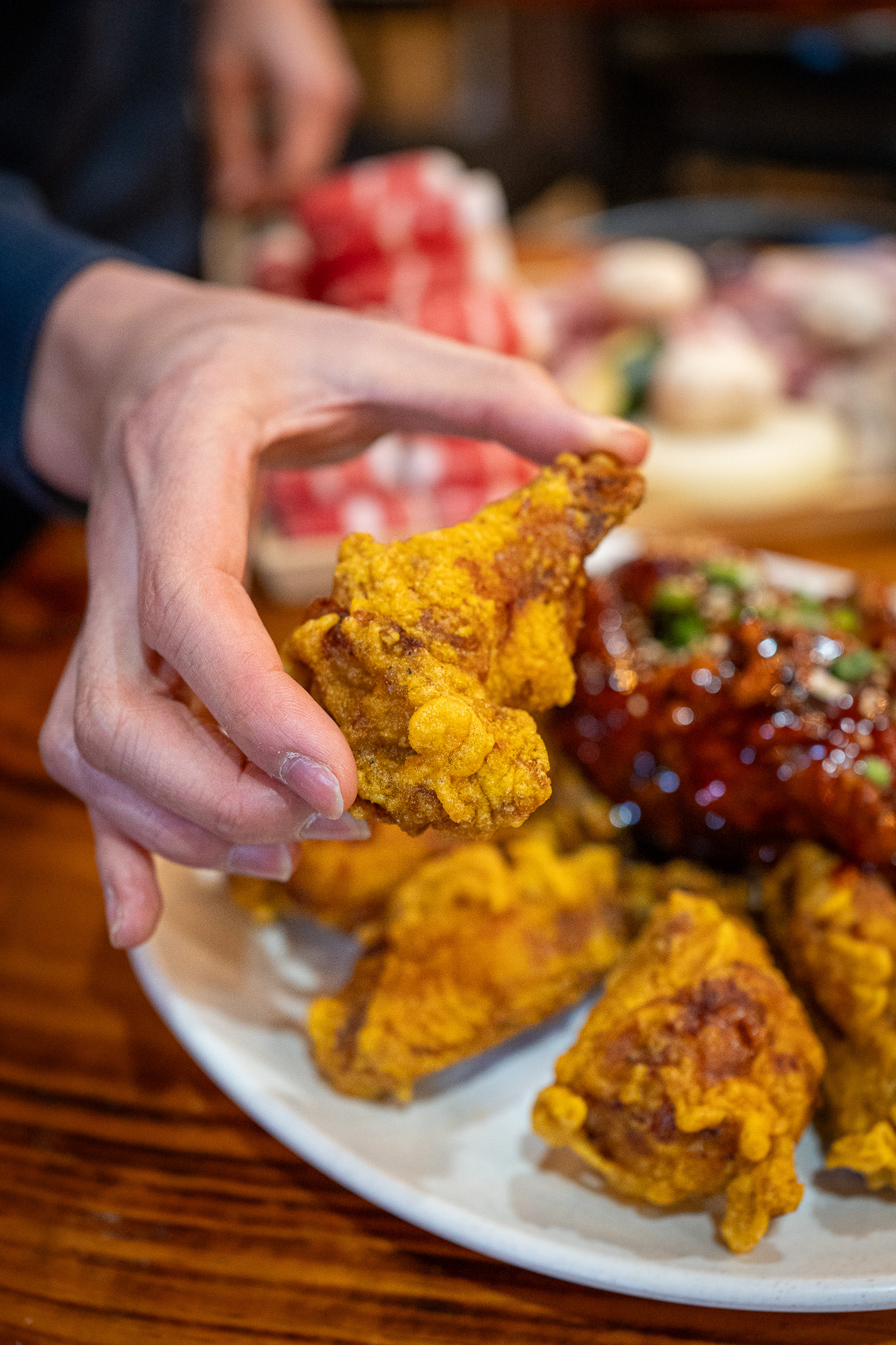
Korean Fried Chicken
Korean fried chicken (KFC) is extremely popular worldwide. The batter can be dry and double-fried, or tossed in a variety of sauces.
Chimaek (치맥) is portmanteau for the words chicken and maekju (beer). It’s widely served all over the world. It’s a tradition where fried chicken is paired with beer and a few daikon and kimchi pickles on the side.
People typically get together and snack on some chimaek while they catch up.
#2 Japchae (잡채)
Japchae is stir-fried sweet potato glass noodles with vegetables and sometimes a protein such as beef. The noodles are super stretchy and silky.
This dish has a slightly sweet soy flavor and is often eaten with other dishes.
#3 Mandu – 만두
Mandu are Korean dumplings often filled with veggies, meat (pork, chicken, or seafood) and then folded into a circular shape.
They are then deep fried (군만두), steamed (찐만두), or eaten in a soup with noodles (Mandu-guk – 만두국).
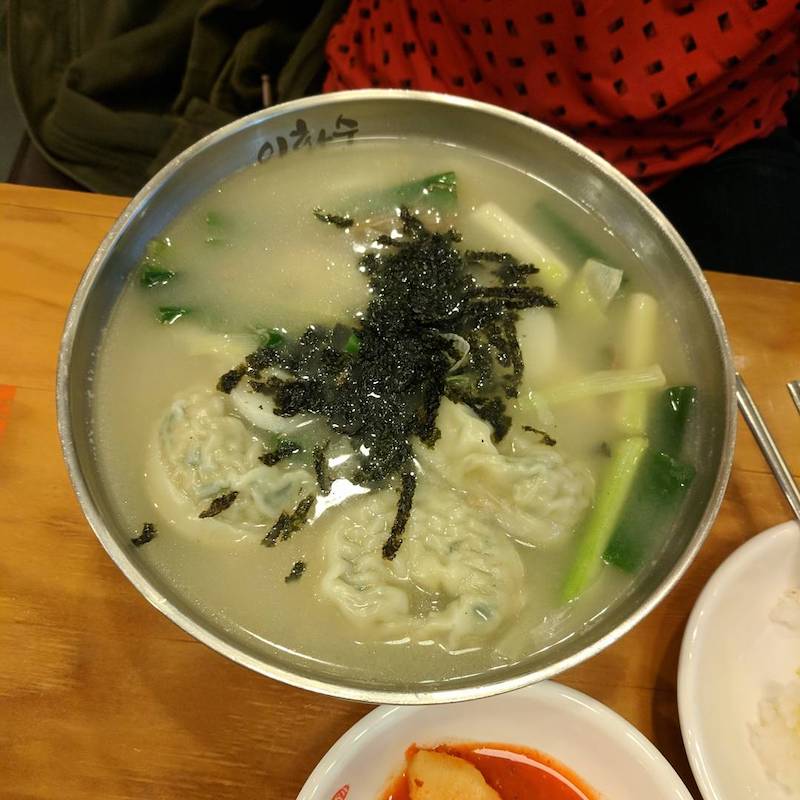
Mandu-guk (Dumpling Soup)
#4 DdukBokki or Tteokbokki (떡볶이)

Tteokbokki (Spicy Rice Cake)
Tteokbokki is a spicy rice cake dish that is often eaten as a street food in Korea. In Korea, you can buy a small tray of tteokbokki from a street vendor for only $1 USD!
The dish contains chewy logs of rice cakes submerged in a flavorful yet spicy red sauce. You can add fish cake (oden), veggies (sliced green and white onion, carrots), boiled eggs, and boiled ramen noodles to the dish for added texture and flavor.
#5 Seafood Pancake (Haemul Pajeon – 해물파전)
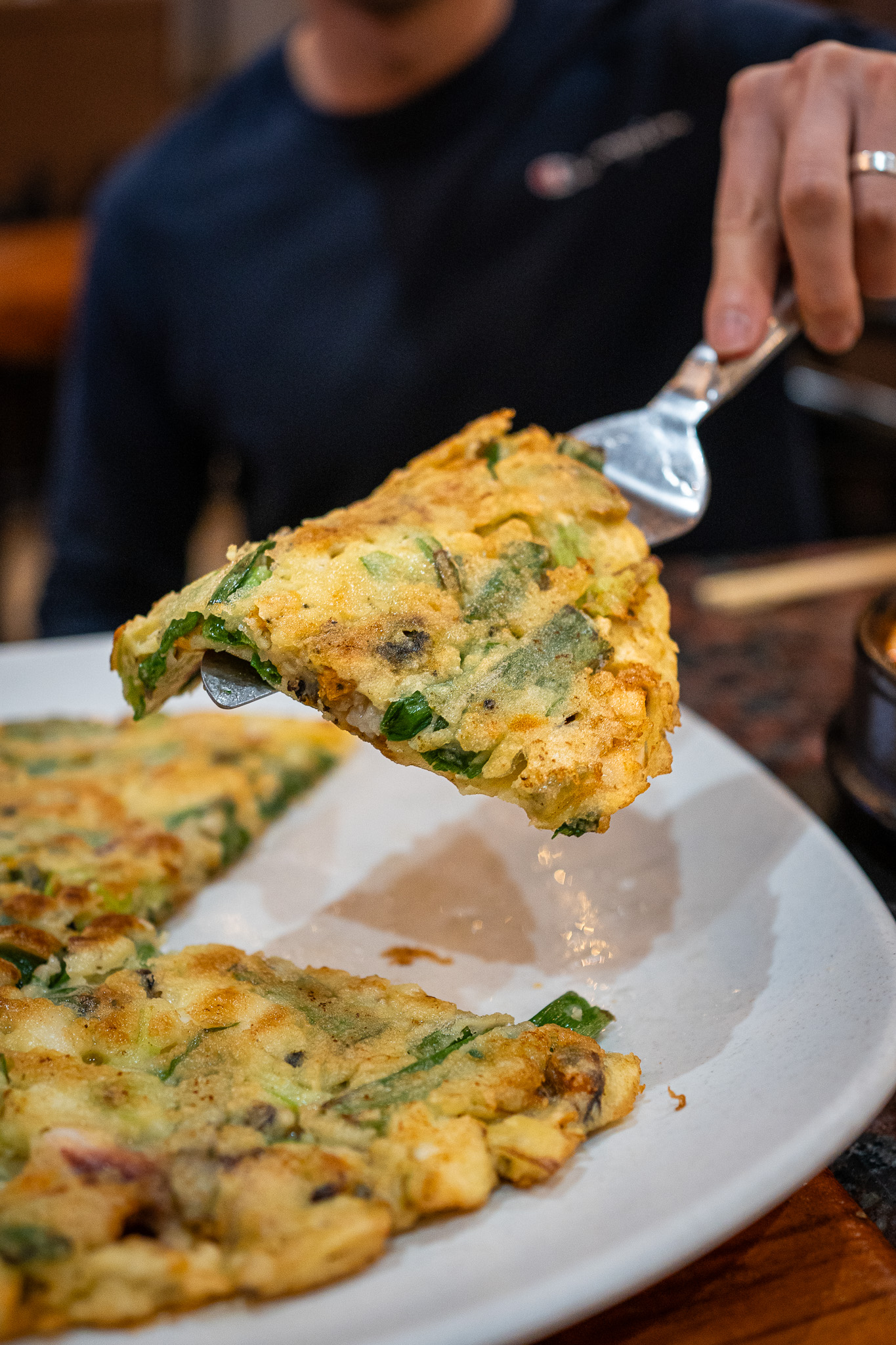
Seafood Pancake
Korean pancakes are always large and great for sharing. They are made from rice flour, veggies, and squid or shrimp. It’s then battered and pan-fried until crispy on either side.
It comes with a tangy dipping sauce. The sauce contains soy sauce, sugar, sesame seeds, green onions, and apple cider vinegar.
#6 Vegan Korean Pancake/Pajeon (김치파전)
Korean pancakes can also be made vegan with just kimchi or green onions.
#7 Seasoned Raw Beef Tartare (Yukhoe: 육회)

Yukhoe – Korean Beef Tartare
This refreshing dish is made from slivers of chilled raw beef mixed with a marinade and then topped with an egg. The dish is eaten alone or with slices of refreshing pear.
We love eating this dish in the summer or as an appetizer. It’s so tasty.
We also highly recommend eating it all at once at its peak freshness. You can save it for later, but it’s just not the same.
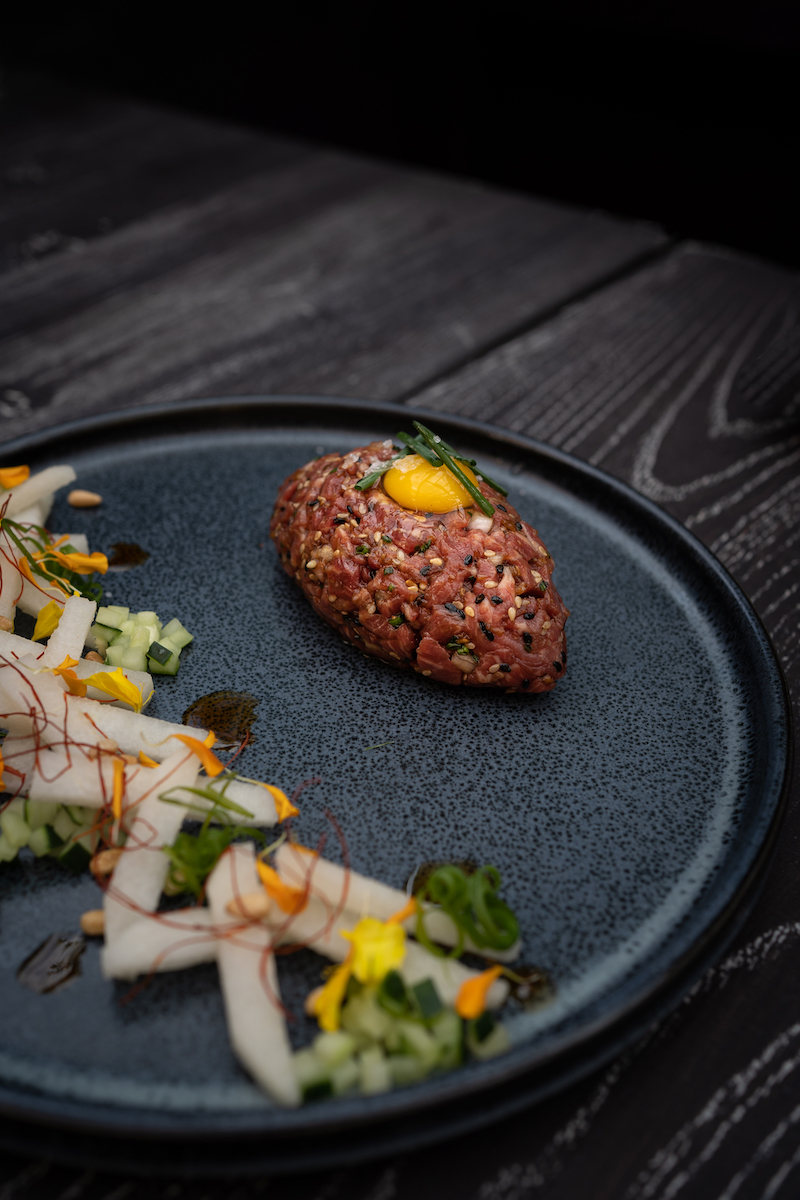
Yukhoe from WeRo in Seattle, WA
#8 Raw Marinated Crab (Ganjang Gejang – 간장게장)
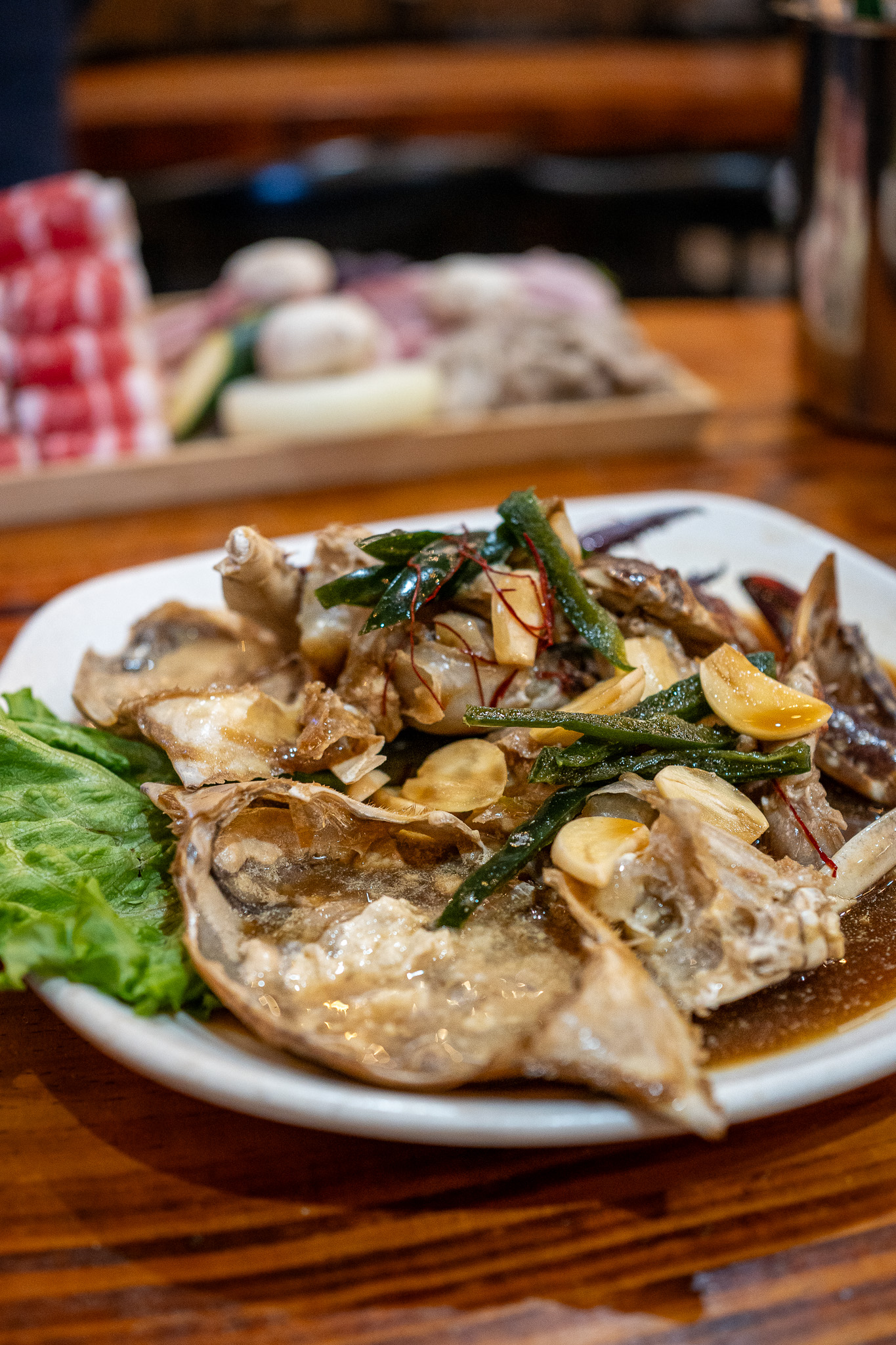
We didn’t know how much we were missing out on this dish until our friends at New Gangnam Korean BBQ showed us how to eat this refreshing dish.
Soy sauce crab or Ganjang Gejang (간장게장) is a marinated crab dish that has a complex, bitter, and umami flavor. It is fermented for up to three days in a marinade that is cooked, chilled, and then re-added to the raw crab to further ferment.
To eat the dish, you squeeze out the crab meat onto steamed rice, add a few spoons of the marinade, a few drops of sesame oil, and mix it into the rice. It’s a unique flavor that should be eaten before any hot dishes on the table.
The flavors will be a combination of bitter, savory, and umami.
You can also order this dish spicy (Spicy Raw Crab – 양념게장).
#9 Gimbap (김밥)
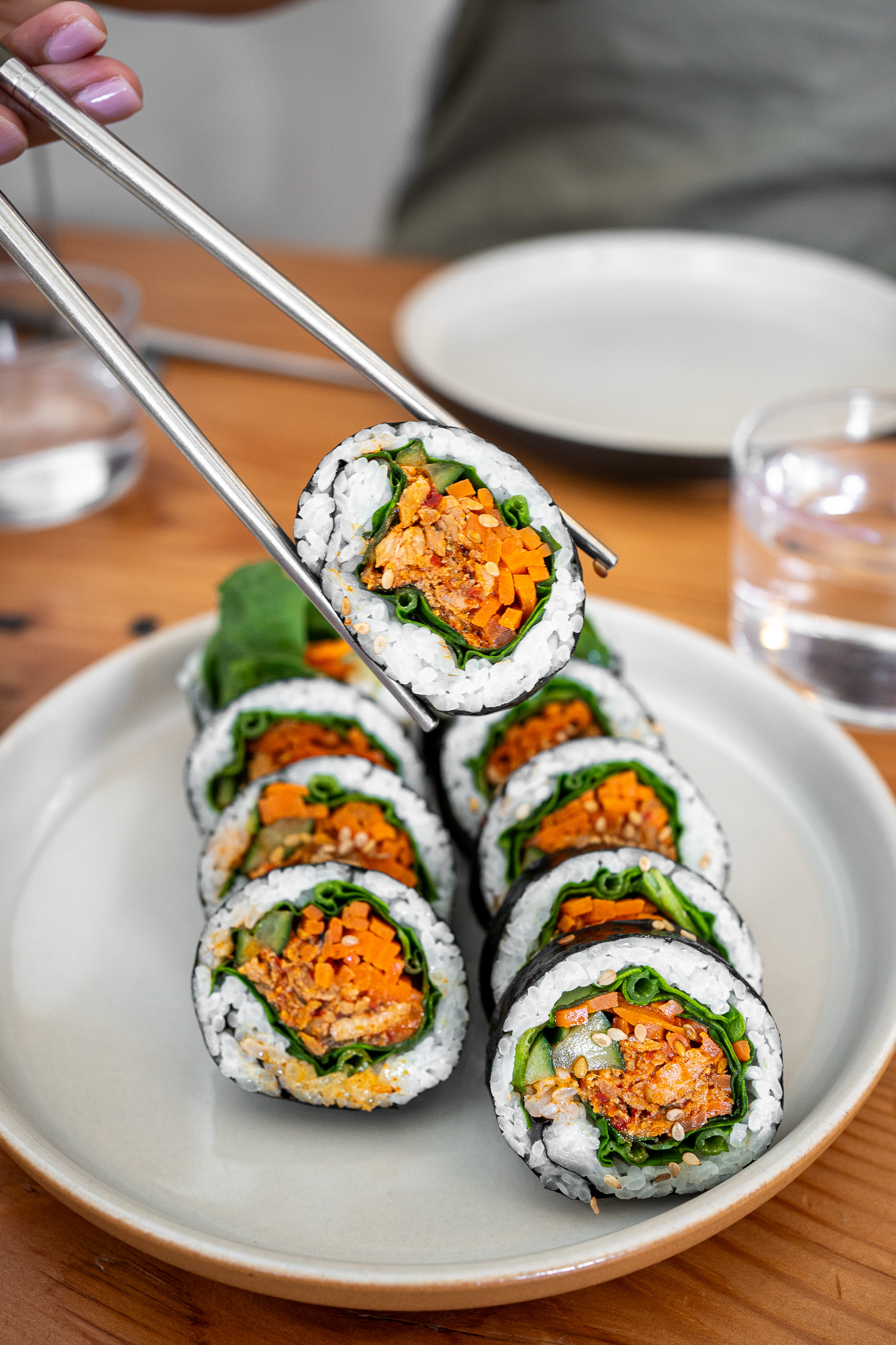
Salmon Kimbap from Made in House (Seattle, WA)
Gimbap or Kimbap is Korean sushi! It’s prepared and served hot to room temperature. It’s very flavorful and filling.
A gimbap roll consists of sauteed vegetables, ground beef, sweet pickled radish, and rice. It’s rolled tightly in a sheet of seaweed (gim) and then sliced into bite-sized circles.
We had a gimbap filled with parilla leaves in Busan and it was so good! You can pretty much fill a gimbap with whatever you desire.
#10 Sundae (순대)
Sundae is a type of sausage that is sold as street food. It has content that is similar to blood pudding, with roots in Mongolian cuisine.
“Real” sundae are pig intestines stuffed with cellophane noodles, vegetables, and meat. Many street vendors will sell a more friendly version without pig intestine.
Soups
#1 Kimchi Soup/Jiggae (김치찌개)
Kimchi soup is very flavorful and comforting. This soup is often made with kimchi, kimchi pickle juice, beef, tofu, and veggies and served with rice.
#2 Soft Tofu Soup (순두부 – Soon Doo Boo)
Soft tofu soup is an experience when you eat Korean food. This dish consists of soup that is cooked in a stone pot. Veggies, protein, and an egg may be added to the soup.
It’s eaten with rice and sometimes a side of bulgogi (marinated BBQ beef) or a small deep-fried mackerel.
#3 Army Stew (부대전골)
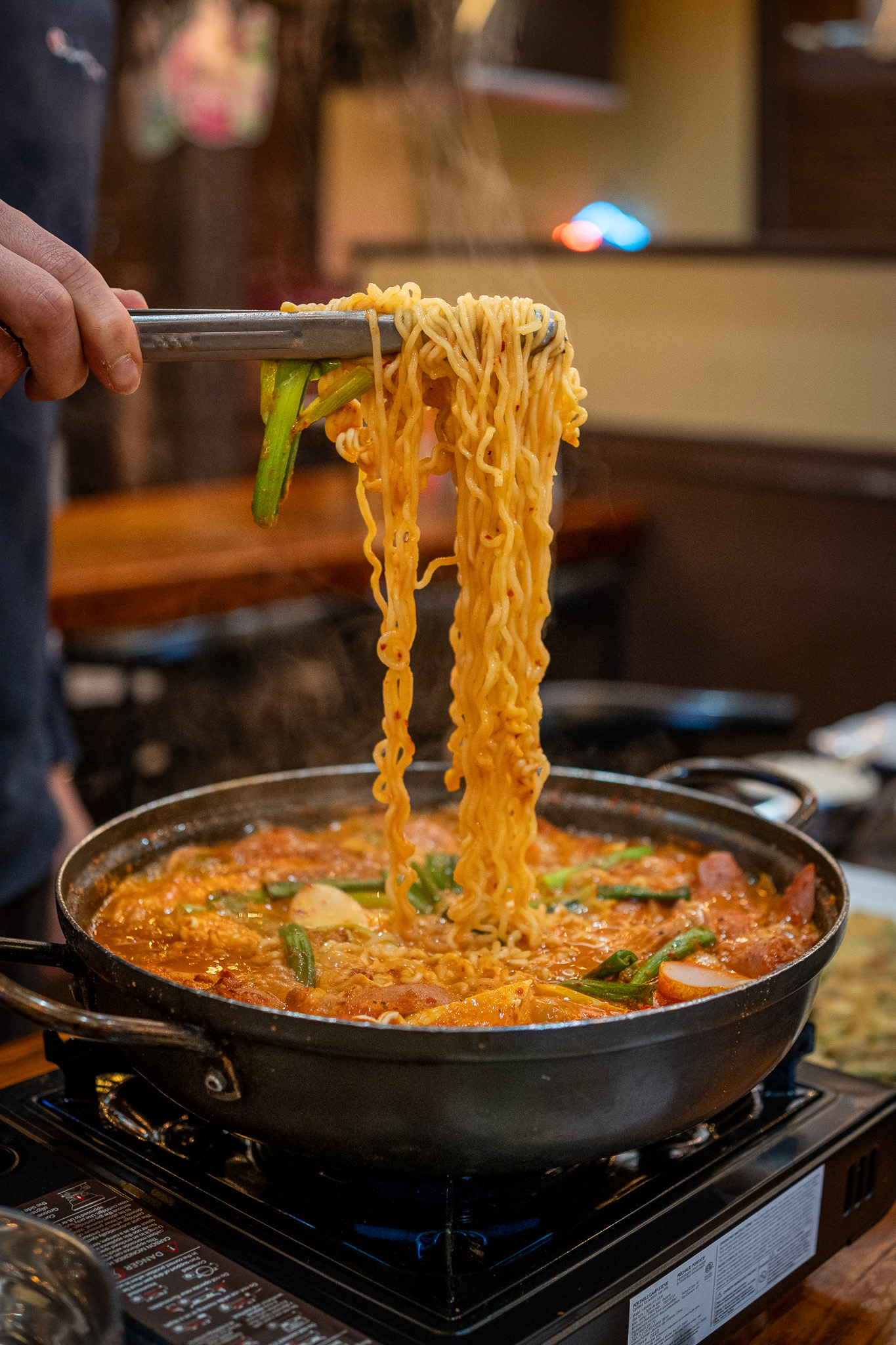
Budae Army Stew Casserole
Army Stew was invented in North Korea during the war and it slowly made its way down throughout Korea.
The stew consists of instant ramen noodles, kimchi, sliced processed meats such as hot dogs and spam, veggies, and a very comforting broth that is not too spicy but very flavorful.
Budae means “military base,” which is where this soup originated.
Today the soup is found worldwide. It’s a hearty soup that can be modified to your liking. Add and remove whatever you desire to this warm and comforting dish.
Did you know that instant ramen was invented in 1958 by a Japanese man by the name of Momofuku Ando? His first creation was the chicken instant ramen.
#4 Ginseng Chicken Soup (Samgye-Tang)
This comforting ginseng chicken soup consists primarily of a whole young chicken filled with garlic, rice, jujube, and ginseng and then cooked for a few hours.
It’s a traditional soup that is good for your health.
#5 Hangover Stew (해장국)
South Korea’s intense drinking culture requires a lot of healing soups.
Hangover stew is made from a beef broth, with cabbage, bean sprouts, radish, and chunks of congealed ox blood. Its deeply satisfying taste helps kick-start your brain and body the next morning.
View this post on Instagram
#6 Ox Bone Soup (Seolleongtang – 설렁탕)
Seolleongtang is a broth made from ox bones, brisket, and other body parts. It’s cooked for more than 24 hours and comes to the table as a milky white soup.
It’s typically unseasoned so you can add as much or as little salt as you need to your liking. The soup is very healthy for the body and mind.
#7 Pepper Beef Soup (육개장 – Yuk Gae Jang)
Yukgaejang is a hearty, spicy beef soup that’s very popular in Korea. It’s made with shredded beef, lots of scallions (pa, 파), other vegetables, and potato noodles.
It’s great for warmer weather.
#8 Potato Pork Backbone Soup (Gam Ja Tang – 감자탕)
Gamja-tang is also known as pork back-bone stew. It’s a spicy Korean soup made from a pig’s neck or spine bones and is often made with potatoes, greens, perilla leaves, cellophane noodles, green onions, hot peppers, and ground sesame seeds.
Gamja-tang originated in the southern Korean province of Jeolla, and its roots can be traced back to the Three Kingdoms era. In the Incheon dock area, construction laborers created the dish as a cheap and hearty meal after a long day of work.
Noodles
#1 Naengmyeon
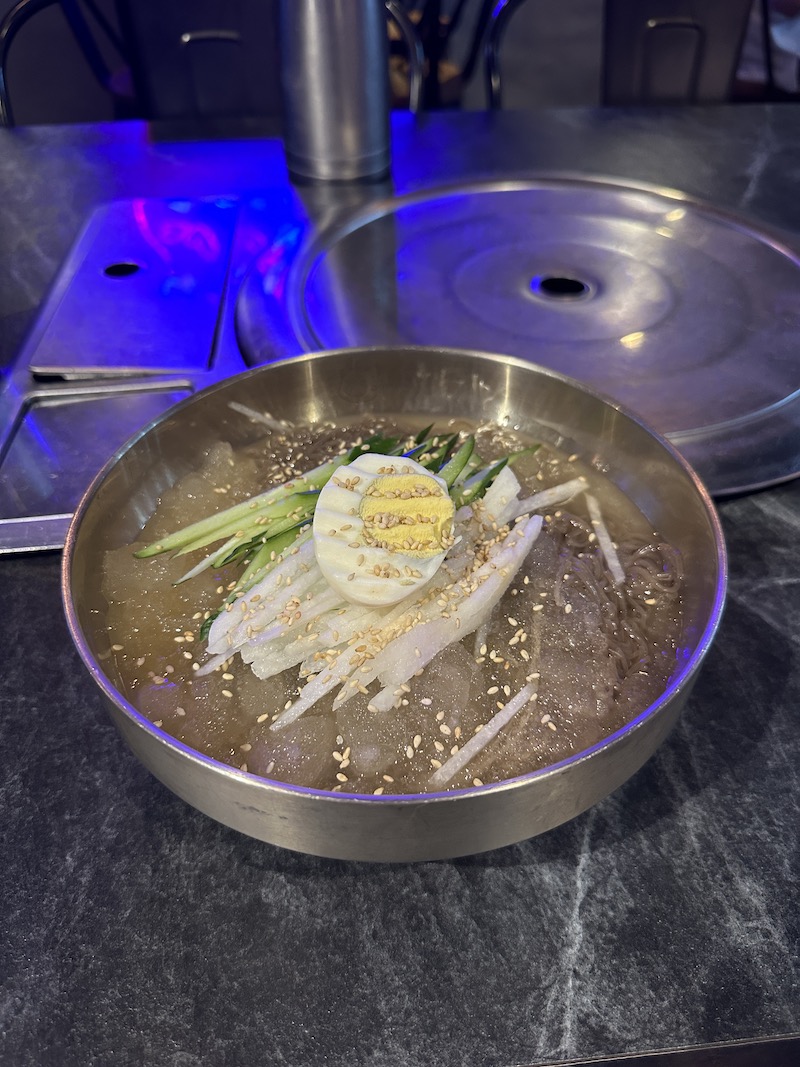
Mul Naengmyeon
Naengmyeon is a very stretchy noodle made from a variety of flours. The dish is often served cold and is great for summer.
The flavors of naengmyeon are often tangy and savory. Spicy naengmyeon will be spicy.
Here are some naengmyeon options that you should try:
- Mul Naengmyeon (물냉면) – Watch our VIRAL naengmyeong video!
- Spicy Cold Buckwheat Noodles (Bibim Naengmyeon – 비빔냉면)
- Cold Buckwheat Noodle Soup + Kalbi (냉면 + 갈비)
View this post on Instagram
View this post on Instagram
#2 Jjajangmyeon (짜장면)
Although originally a Chinese dish, Koreans have taken the noodles and created a thicker, sweeter version that holds only a vague resemblance to its Chinese predecessor.
Jjajangmyeon consists of flour noodles that are topped with a sweet and savory gravy made from beans, potato and other vegetables. It’s dark color looks daunting, but the flavor is very comforting. Expect to slurp up every last noodle.
#3 Jaengban Guksu (쟁반국수 (메밀/냉면))
This cold noodle dish is perfect as a pot luck dish or an accompanying dish to your Korean BBQ.
#4 Kalguksu (칼국수)
Kalguksu means “knife noodles” and refers to a Korean noodle dish consisting of handmade, knife-cut wheat flour noodles served in a large bowl.
Entrees
#1 Bibimbap (비빔밥)
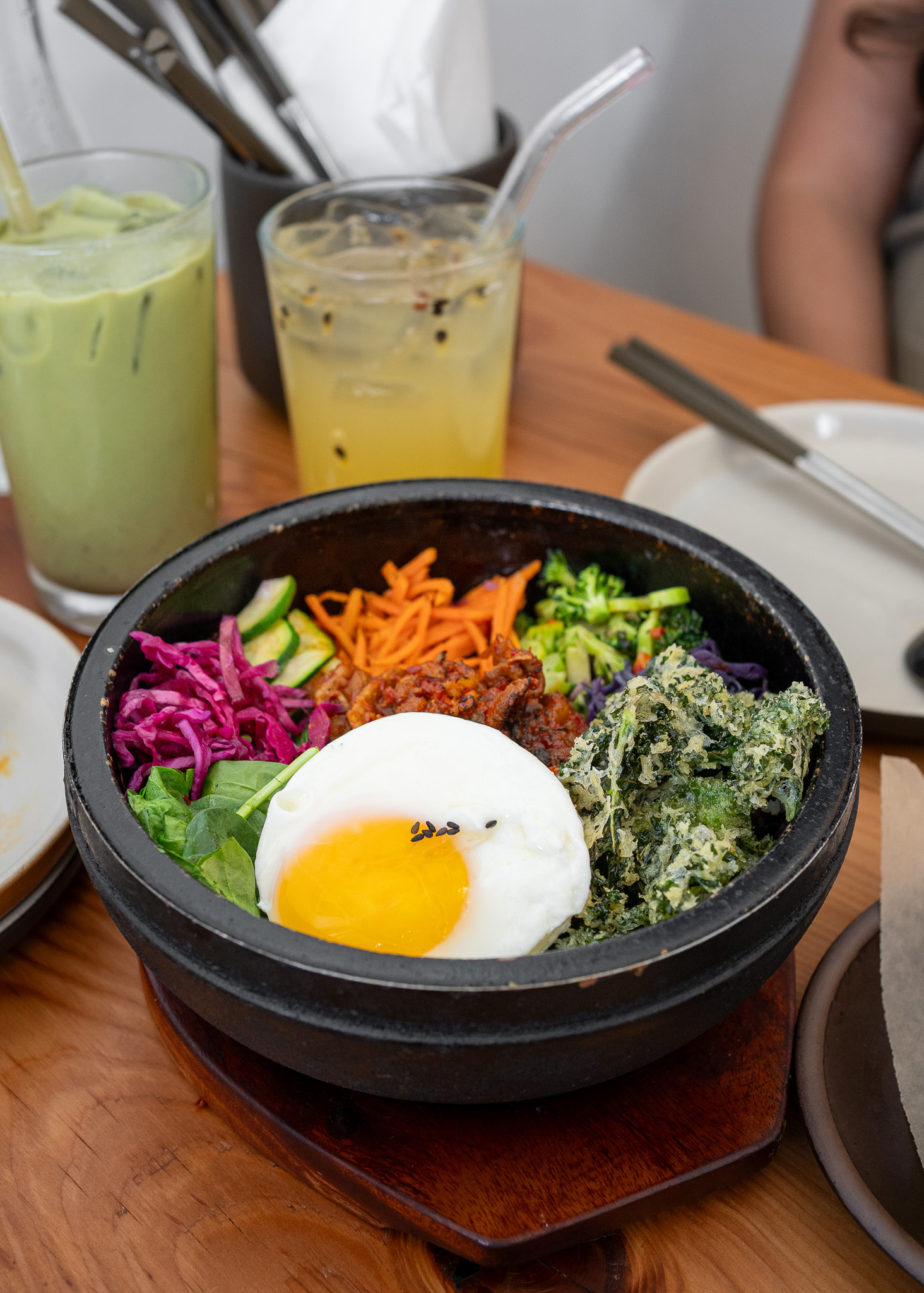
Bibimbap from Made in House (Seattle, WA)
Bibimbap is a Korean rice dish that is often served in a stone bowl or metal bowl.
The term bibim means “mixing” and bap is steamed rice. It is served as a bowl of warm white rice topped with seasoned veggies (namul – 나물) and gochujang (red fermented spicy paste).
Egg and sliced meat are common additions. The dish is then stirred together thoroughly just before consuming.
View this post on Instagram
#2 Bossam (보쌈)
Bossams is often a shared dish that consists of steamed pork that is then sliced into bite sizes and eaten in lettuce wraps with parilla or grape leaves, kimchi, sliced or whole garlic, and a flavorful dipping sauce.
Sauces that people typically have with Bossam include:
- Ssamjang – Paste made of chili and soybean paste (doenjang)
- Saeujeot – A very salty pink sauce made of tiny pickled shrimp
Korean BBQ
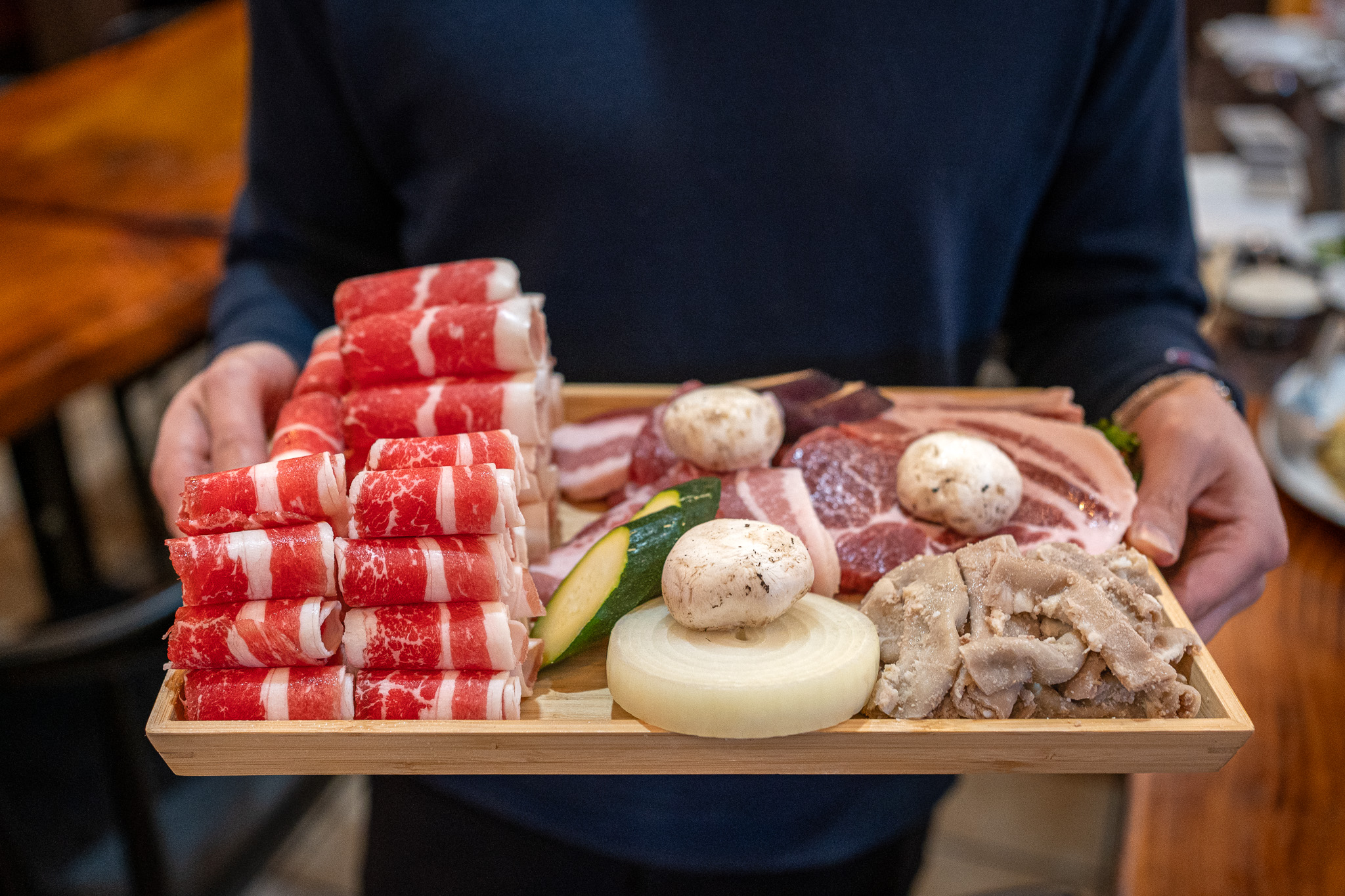
Korean BBQ deserves its own section.
Here are some popular meats you’ll try when eating Korean BBQ:
- Tong Kalbi (Beef Ribs) – 통(양념)갈비
- Bulgogi (불고기)- Bulgogi translates to “fire meat.” It’s thin, marinated slices of meat, most commonly beef, grilled on a barbecue or on a stove-top griddle. It is also often stir-fried in a pan in home cooking. Sirloin and rib eye are frequently used cuts for bulgogi.
- Unmarinated Kalbi (Beef Ribs) – 생갈비
- Raw Beef Ribeye – 생등심
- Boneless Sliced Kalbi (Beef Ribs) 갈비살
- Lightly Marinated Beef Sirloin 주물럭
- Angus Beef Brisket – 앵거스 차돌
- Tong Black Pork Belly (Samgyeopsal)- 흑돼지 통삼겹살
- Sliced Black Pork Belly (Samgyeopsal)- 흑돼지 삼겹살
- Beef Short Ribs – LA갈비
- Pork Back Ribs – 돼지갈비
- Spicy Pork Bulgogi – 돼지불고기
- Chicken BBQ – 닭불고기
- Spicy Chicken BBQ – 매운닭불고기
- Gopchang (곱창) – The small intestines from pork or cattle, which, chopped into rounded sections. It can be cooked into soups, stir-fried, or grilled. It’s chewy without being rubbery.
Popular Korean BBQ Side Dishes
- Gyeranjjim (계란찜) – This side dish, in which an egg is beaten into a bowl, lightly salted and steamed into a spongy, pale yellow cake, is absolutely essential when eating spicy food. Similar in consistency to soft tofu (sundubu), but with more flavor, gyeranjjim is sometimes made with diced mushrooms, carrots, zucchini, leeks, and sesame seeds sprinkled on top.
- Corn Cheese – Cheese and corn are added in a smaller aluminum tray and then placed on top of the grill to melt. It’s amazing on its own or used as a dip for your KBBQ meats.
- Pickled Daison Radish Wraps – These pickled wraps are perfect for creating small tacos for your KBBQ meat.
- Rice Sheets – Another great vessel for your KBBQ meats. Add your meat, sauce, kimchi, and veggies onto a rice sheet and take a bite!
- Salad – A green leaf salad is often eaten with KBBQ.
- Kimchi – Fermented napa cabbage side dish that tastes tangy and fishy.
- Steamed Rice – Great for soaking up sauces and meat fats and juices.
View this post on Instagram
BBQ Chicken (Dakgalbi – 닭갈비)
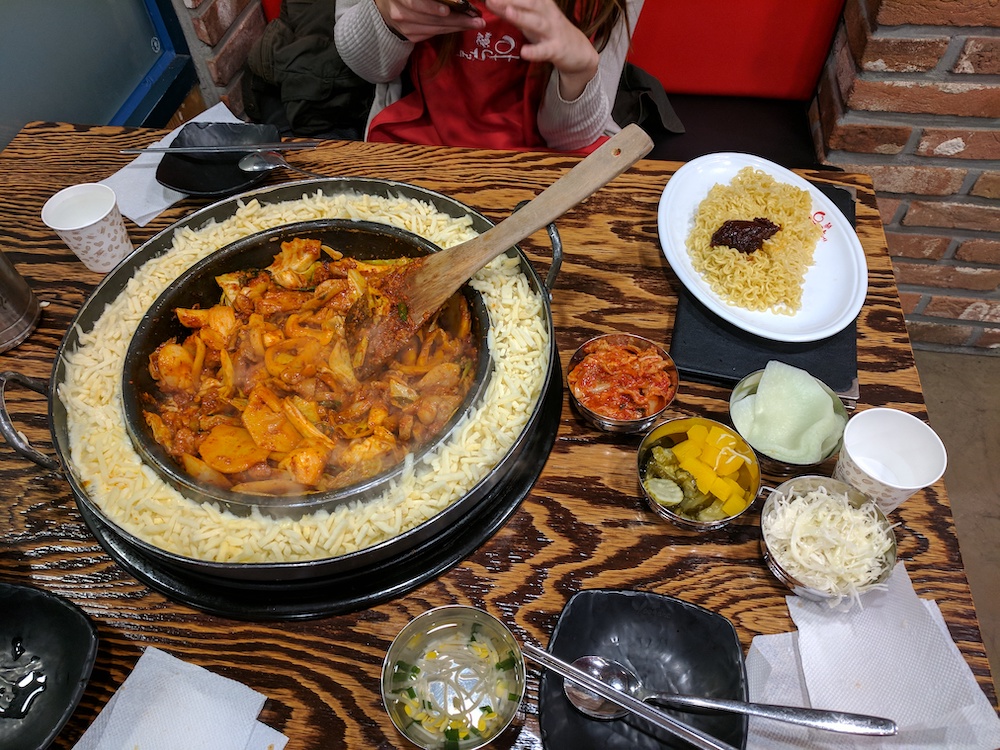
Cheese Dakgalbi
Dakgalbi is a delicious, spicy grilled chicken dish that’s a popular choice for those on a budget or groups who want to gather and eat.
It consists of chicken and veggies grilled in the center and then a ring of melted cheese (often mozzarella) that you then dip the dakgalbi into.
At the end of the meal, staff will come by your table to add rice to the grill and take all the remaining ingredients to create a cheesy chicken fried rice for you to eat and then take home.
Dessert
#1 Bingsu
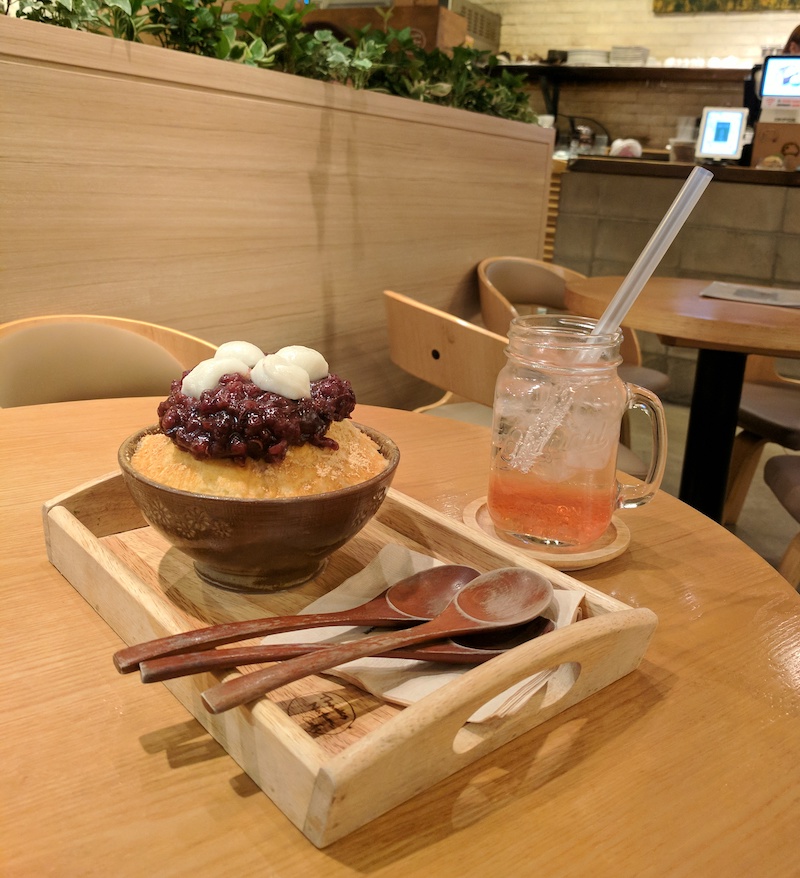
Bingsu, or shaved iced, is a very refreshing dessert that has become very popular beyond Korea.
It’s a bowl filled with shaved ice and then topped with fruits, jellies, mochi, red beans, green tea, condensed milk, and fruit syrups.
It’s made to be shared, but you can always enjoy it alone!
#2 Yaksik
Yaksik is a rice cake made from glutinous rice. Yaksik is sweetened with honey and decorated with pine nuts, chesnuts, and dried fruit, like raisins. The texture of yaksik is sticky, and it has a slightly salty flavor from the nuts and sesame oil.
#3 Brick Toast (Honey Bread)
View this post on Instagram
#4 Baesuk (Steamed Pears)
#5 Hoppang
#6 Hotteok
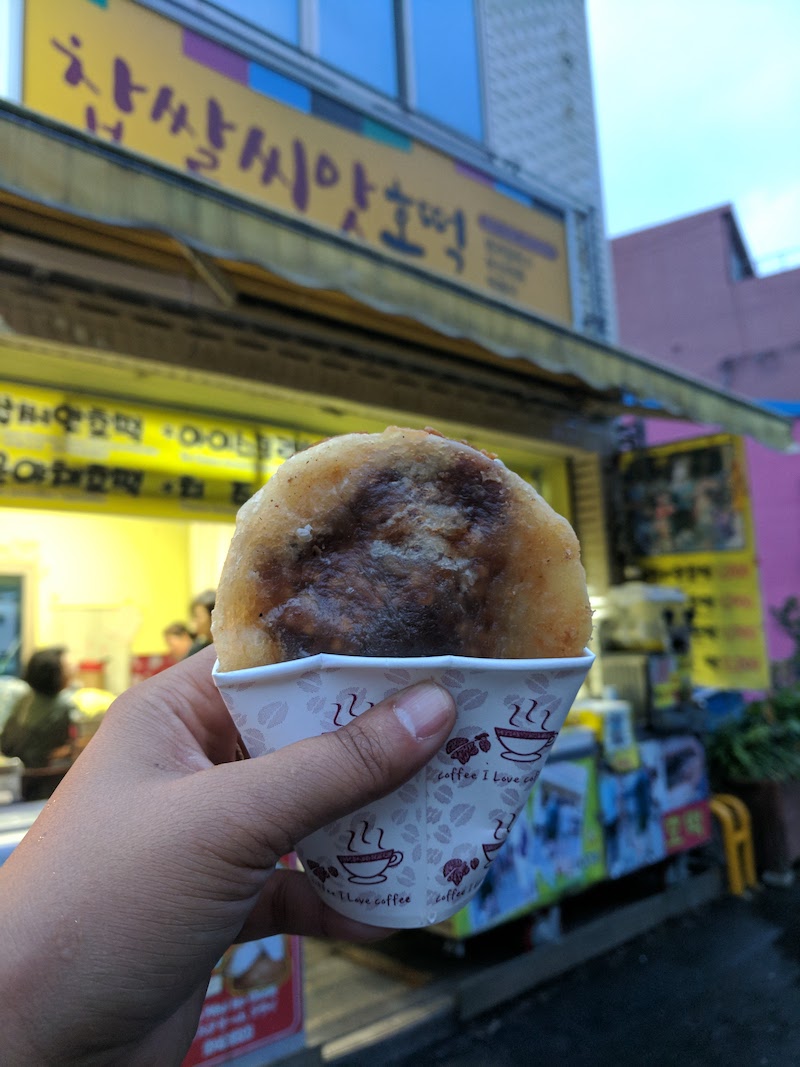
Hotteok
The pancake-looking dessert is filled with honey, cinnamon, and nuts. The exterior is crispy and as you bite through the layers, it starts to get chewy, sweet, and crunchy.
It’s very popular in the Winter because they are pan-grilled and keep your hands warm. The smell is also very warming and reminiscent of the holidays.
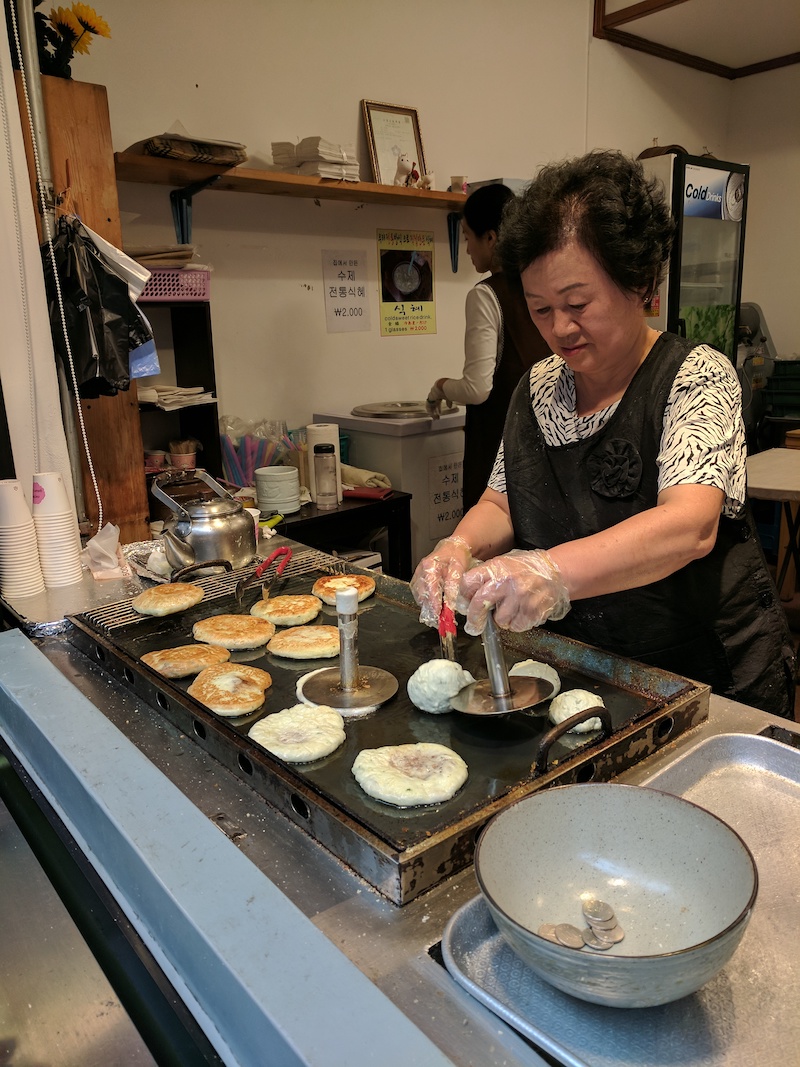
Lady making Hotteok
#7 Dalgona
Dalgona, or ppopgi as its known in Korea, is a street food candy, made from melted sugar and baking soda. It’s very similar to toffee and was popularized by the show Squid Games.
The caramel-colored discs of candy are often stamped with shapes such as hearts or stars. Dalgona is also the name of a type of whipped coffee drink, which also originated in Korea.
#8 Gyeongdan (rice balls)
#9 Bungeoppang (fish-shaped pastry)
Bungeoppang translates to “carp bread.” It’s a fish-shaped vessel that is prepared in a grilled mold (similar to a waffle) and then filled with red beans, custard, ice cream, or even cheese! It’s crispy on the outside and can be eaten with your hands.
This is a street food that’s very popular in the wintertime.
#10 Dasik (pressed cookies)
These delicately patterned cookies may look too attractive to eat, but we recommend doing it anyway.
Usually made from rice flour or soybean flour, dasik comes in a range of natural colors and flavors and are pressed into a mold to imprint shapes, letters, and flower patterns.
The colors typically match the flavor and are served with tea. The cookies break down and melt in your mouth as it comes in contact with your saliva.
Dasik dates back to the Joseon Dynasty (1392-1910) when the cookies were piled high on a plate as an important part of ancestral rites, holidays, and other ceremonies. Different flavors also had medicinal purposes, such as sesame for treating food poisoning and the acorn as a cough suppressant.
#11 Songpyeon (Rice Cake)
Songpyeon are half-moon-shaped rice cakes. They look like dumplings but they are bite sized and can be filled with ingredients such as red bean paste, honey, chestnut, and sesame.
The dough is often colorful. This dessert is common during the Korean celebration of chuseok (a fall harvest festival that translates to “autumn eve”).
The taste is sweet, nutty, and chewy, with a subtle pine tree flavor from steaming the rice cakes in fresh pine needles (the song in songpyeon means pine tree).
Songpyeon is perfect for anyone who enjoys chewy, mochi-like desserts.
Beverages
#1 Boricha
Barley tea can be consumed hot or cold. It has a nutty flavor and is a great beverage to have with any Korean dish.
#2 Soju (소주)
Soju is Korea’s national beverage. It’s a clear and colorless Korean distilled alcoholic beverage that is usually consumed neat.
It can also be mixed with juices or purees and served to groups.
Its alcohol content varies from about 12.9% to 53% alcohol by volume. You can easily get soju anywhere in Korea. We love buying them from 7-Eleven stores where the soju can be as cheap as $1 USD a bottle!
#3 Beer or Mekju (맥주)
Mekju is Korean beer. It’s typically light in flavor and very easy to consume.
Popular Korean beer brands include Hite, CASS, OB, and KLOUD.
#4 Makgeolli (막걸리)
Rice wine that is drinking on its own or can be sweetened. It’s similar to Japanese nigori sake wine.
#5 Somaek (소맥)
Somaek is a portmanteau of the words Soju and Mekju. It’s a cocktail made of mixing soju and beer.
It’s similar to a sake bomb but made with Korean ingredients instead.
If you found our best Korean dishes to try helpful, please share it on Pinterest. Thanks for your support!
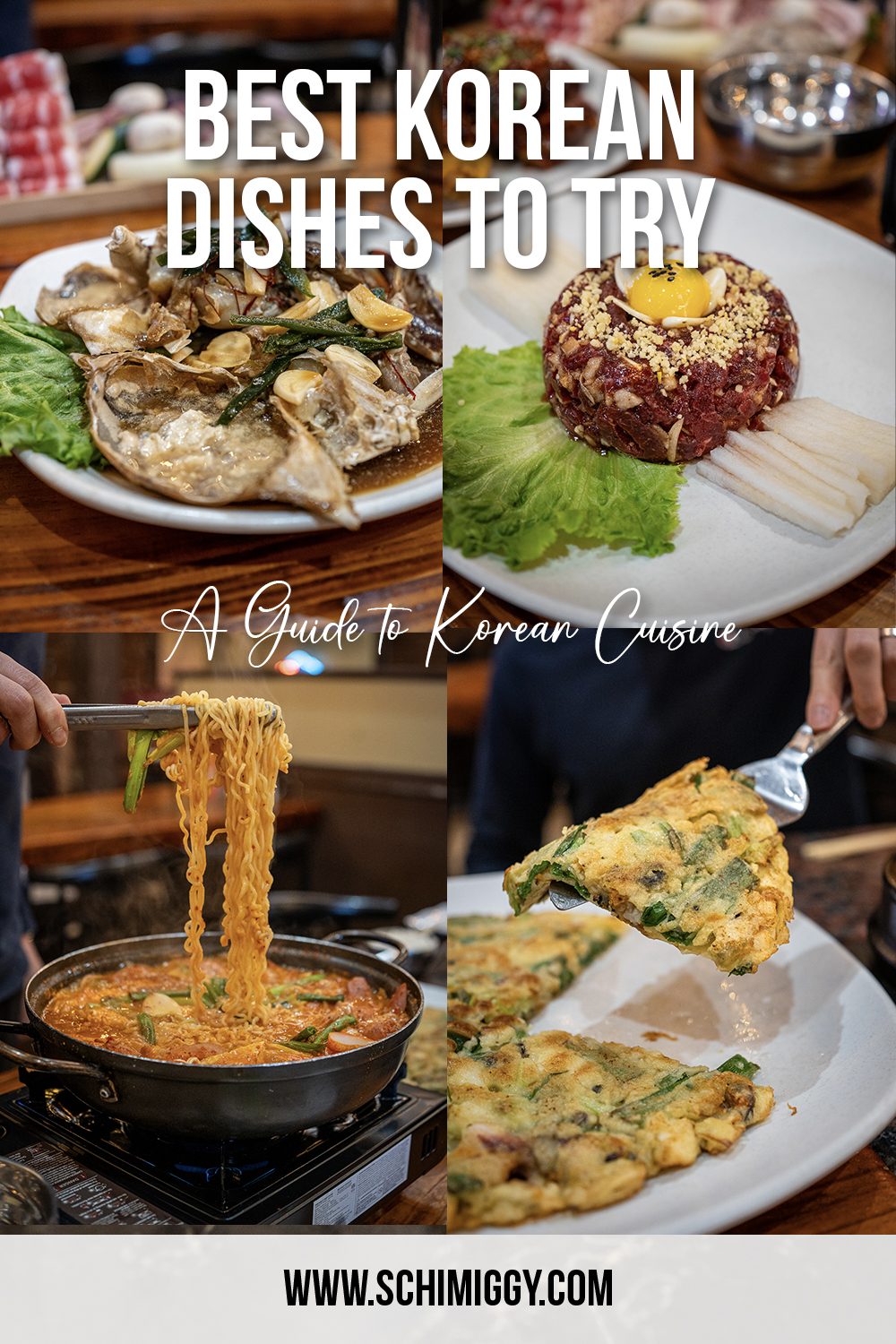
Thank you for visiting today! If you found this encouraging or informative, please connect with us on Instagram or TikTok. Sign up for our monthly newsletter for updates and more. We promise we won't spam you! Feel free to unsubscribe anytime. If you're a brand and want to work with us, please visit this page to get in touch.

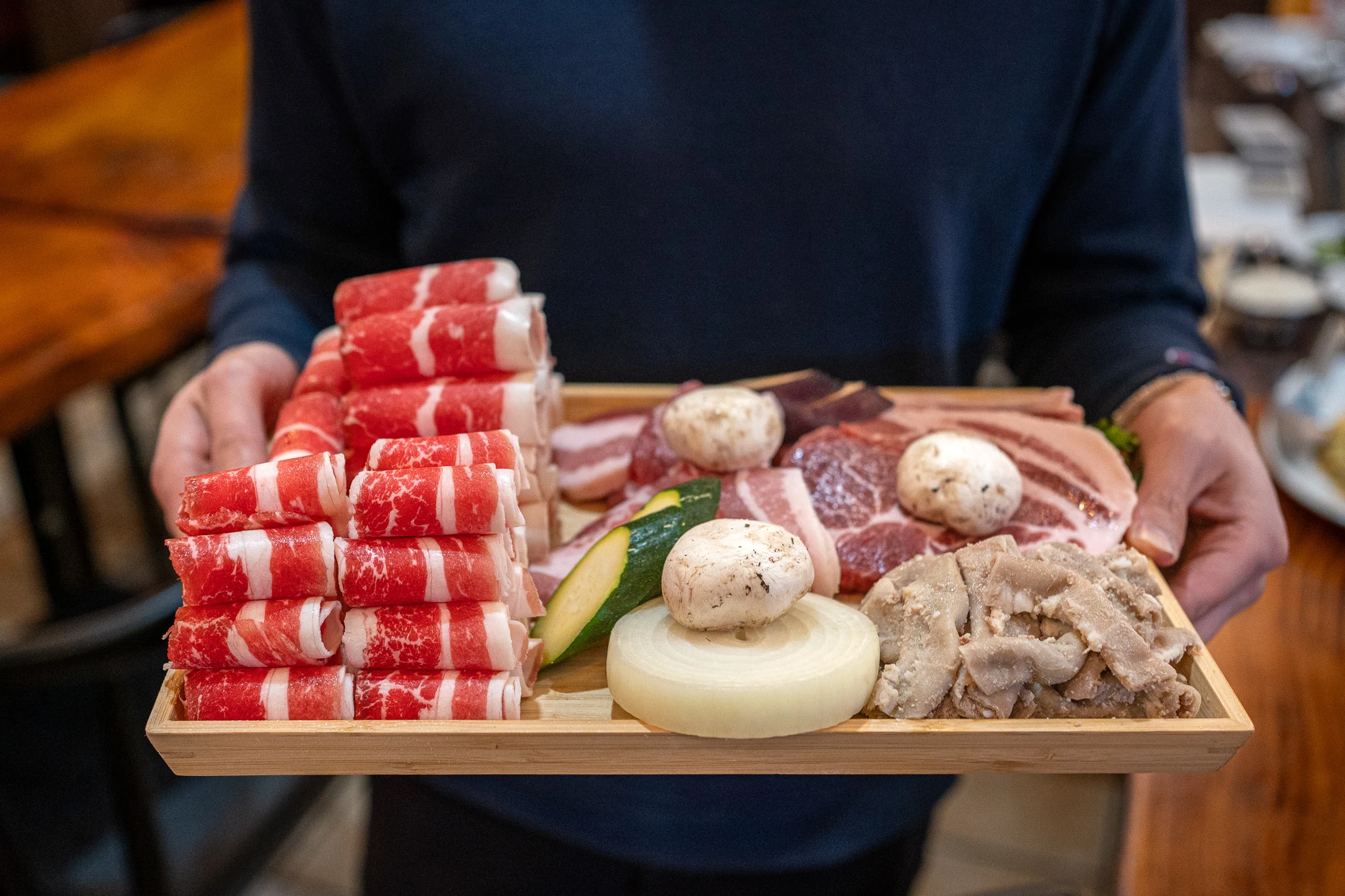

Arabian Tea House
Thursday 30th of October 2025
Looking for halal restaurant in podgorica? Don’t worry Arabian Tea House is the best halal restaurant in Podgorica, Montenegro that serves authentic emirati cuisine